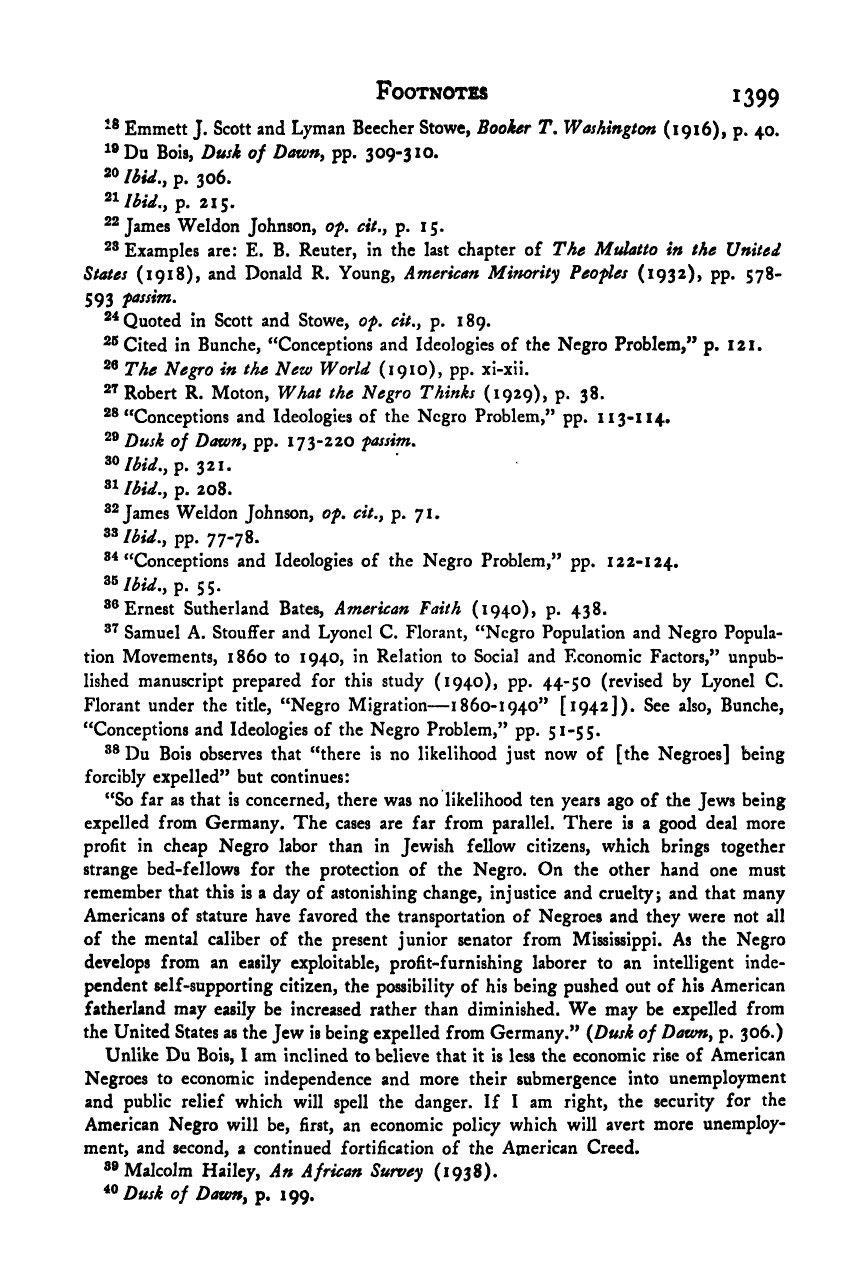Note: Gunnar Myrdal died in 1987, less than 70 years ago. Therefore, this work is protected by copyright, restricting your legal rights to reproduce it. However, you are welcome to view it on screen, as you do now. Read more about copyright.
Full resolution (TIFF) - On this page / på denna sida - Footnotes - Chapter 38

<< prev. page << föreg. sida << >> nästa sida >> next page >>
Below is the raw OCR text
from the above scanned image.
Do you see an error? Proofread the page now!
Här nedan syns maskintolkade texten från faksimilbilden ovan.
Ser du något fel? Korrekturläs sidan nu!
This page has never been proofread. / Denna sida har aldrig korrekturlästs.
Footnotes 1399
Emmett J. Scott and Lyman Beecher Stowe, Booker T. Washington (1916), p. 40.
^®Du Bois, Dusk of Dawn^ pp. 309-310.
IbU,^ p. 306.
lbU,y p. 215.
James Weldon Johnson, of, cit,, p. 15.
Examples are: E. B. Reuter, in the last chapter of The Mulatto in the United
States (1918), and Donald R. Young, American Minority Peofles (1932), pp. 578-
593 fassim.
Quoted in Scott and Stowe, of, cit,y p. 189.
Cited in Bunche, “Conceptions and Ideologies of the Negro Problem,” p. I2l.
The Negro in the New World (1910), pp. xi-xii.
Robert R. Moton, What the Negro Thinks (1929), p. 38.
“Conceptions and Ideologies of the Negro Problem,” pp. 113-114.
Dusk of Downy pp. 173-220 fassim,
p. 321.
Ibid,y p. 208.
32
James Weldon Johnson, of, cit,y p. 71.
^^lbid,y pp. 77-78.
3^*
“Conceptions and Ideologies of the Negro Problem,” pp. 1 22-1 24.
^^Ibid., p. 55.
3® Ernest Sutherland Bates, American Faith (1940), p. 438.
3^ Samuel A. Stouffer and Lyoncl C. Florant, “Negro Population and Negro Popula-
tion Movements, i860 to 1940, in Relation to Social and Economic Factors,” unpub-
lished manuscript prepared for this study (1940), pp. 44-50 (revised by Lyonel C.
Florant under the title, “Negro Migration—1860-1940” [1942]). See also, Bunche,
“Conceptions and Ideologies of the Negro Problem,” pp. 51-55.
33
Du Bois observes that “there is no likelihood just now of [the Negroes] being
forcibly expelled” but continues:
“So far as that is concerned, there was no likelihood ten years ago of the Jews being
expelled from Germany. The cases are far from parallel. There is a good deal more
profit in cheap Negro labor than in Jewish fellow citizens, which brings together
strange bed-fellows for the protection of the Negro. On the other hand one must
remember that this is a day of astonishing change, injustice and cruelty; and that many
Americans of stature have favored the transportation of Negroes and they were not all
of the mental caliber of the present junior senator from Mississippi. As the Negro
develops from an easily exploitable, profit-furnishing laborer to an intelligent inde-
pendent self-supporting citizen, the possibility of his being pushed out of his American
fatherland may easily be increased rather than diminished. We may be expelled from
the United States as the Jew is being expelled from Germany.” {Dusk of DawUy p. 306.)
Unlike Du Bois, I am inclined to believe that it is less the economic rise of American
Negroes to economic independence and more their submergence into unemployment
and public relief which will spell the danger. If I am right, the security for the
American Negro will be, first, an economic policy which will avert more unemploy-
ment, and second, a continued fortification of the American Creed.
3® Malcolm Hailey, An African Survey (1938).
Dusk of Downy p. 199,
<< prev. page << föreg. sida << >> nästa sida >> next page >>